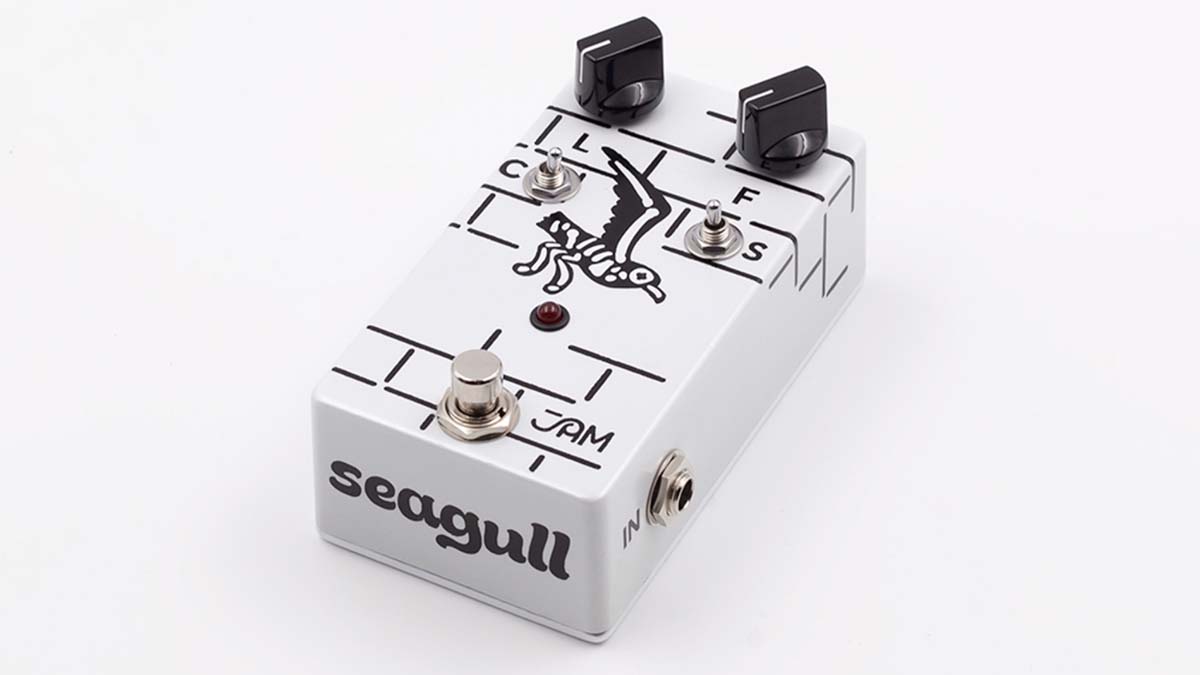Put the gull into Gilmour with Jam Pedals’ Seagull – a cocked wah filter that also replicates Pink Floyd’s Echoes effect
A pedal for David Gilmour superfans to play around with his oscillating caw effect, but also for disciples of Michael Schenker’s cocked wah sound

Jam Pedals has released the latest in its Pink Floyd-inspired lineup, taking the Seagull circuit out of its Pink Flow multi-effects station and housing it in a standalone enclosure with enhanced controls and more sounds to play with.
The Seagull appropriates the Red Fasel inductor found on its Wahcko wah pedal, and puts it to good use, allowing players the chance to replicate the ‘seagull’ effect heard on Pink Floyd’s Echoes, or to run the pedal as a cocked wah filter for nasally vocal tones.
The ‘seagull’ sound effect on Pink Floyd’s Echoes began as so many great electric guitar tones do, with a mistake.
Guitarist David Gilmour is hazy on the year – perhaps 1969 or 1970 – but definitely a time before pedalboard best practice had been established, and somehow his tech had connected his wah pedal the wrong way round. When engaged, the unit howled in protest, an animalistic, avian scream that Gilmour later played around with, tamed, and began to use in song.
According to Gilmourish, the seagull effect was used in early performances of Embryo, a then unreleased track, before being augmented by Gilmour’s Binson Echorec and finding a home on Echoes.
Recreating this at home was not a task for the faint-hearted but the Jam Pedals Seagull should make it a lot more achievable. It has a pair of dials, with L controlling the output level, and F fine-tuning the frequency. And there’s a pair of toggle switches; C chooses between the Seagull and a cocked wah mode, while S is a three-way toggle switch that offers three distinct sweep ranges.
The footswitch can be used as a latching or momentary switch, the latter particularly handy for using the Seagull mid-performance, adding some squawk to your solos.
Get the MusicRadar Newsletter
Want all the hottest music and gear news, reviews, deals, features and more, direct to your inbox? Sign up here.

While Jam Pedals is marketing this as an explicitly Pink Floyd-inspired stompbox – the enclosure of the standard edition even has a black brickwork illustration on a white background a la The Wall – the cocked wah mode is not to be sniffed at, and will pair very nicely with an overdrive or fuzz pedal of your choice.
The likes of Mick Ronson, Frank Zappa and most famously Michael Schenker popularised this use of the wah pedal as a filter. The cocked or parked wah simply involved adjusting your wah’s treadle until you find your chose sweet point in its sweep. Depending on where you set it, the cocked wah might bring out some midrange naval honk, or some bright, rich upper-mids that help you tease harmonics out of your guitar.
Jam Pedals says the Seagull is most suitable for guitars with passive pickups, and advises against placing any pedal with a buffered bypass between your guitar and the Seagull.
Upon engaging the effect, set the output volume and turn your guitar’s volume pot to 10, then adjust the pitch of the effect via the guitar’s tone knob. Changing pickups will change the fundamental pitch of the Seagull effect.

• 5 songs guitarists need to hear… by David Gilmour (that aren't Comfortably Numb)
Lastly, and this, frankly, scarcely needs to be said of a pedal that’s being marketed to Gilmour acolytes, using some reverb and a tape echo or delay pedal with long, languid repeats will elicit some very Floydian sounds.
The Seagull is available now direct from Jam Pedals and selected dealers, priced £149 for the standard edition (with the bird and the wall art work), or £199 for the Custom Artwork edition, which offers a choice of “Fly By”, “Decorum” and “Seagull Soup” designs on the enclosure. Maybe it’s lunchtime talking, but that soup version looks very tasty indeed.
To order or for more details, head over to the Jam Pedals website.

Jonathan Horsley has been writing about guitars and guitar culture since 2005, playing them since 1990, and regularly contributes to MusicRadar, Total Guitar and Guitar World. He uses Jazz III nylon picks, 10s during the week, 9s at the weekend, and shamefully still struggles with rhythm figure one of Van Halen’s Panama.
“A fully playable electro-mechanical synth voice that tracks the pitch of your playing in real time”: Gamechanger Audio unveils the Motor Pedal – a real synth pedal with a “multi-modal gas pedal”
“Instead of labouring over a perfect recreation, we decided to make an expanded counterpart”: Chase Bliss teams up with Mike Piera for Analog Man collab based on the legendary King Of Tone










